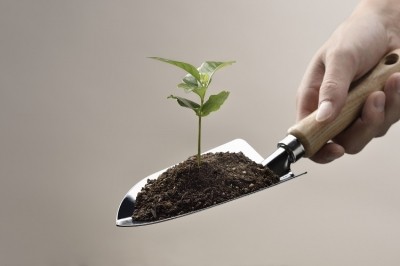Unilever unearths regen ag findings for Knorr and Hellmann’s: ‘The time for pilots is over. It’s time to go big’

In 2020, Unilever pledged to invest €1bn in climate, nature and resource efficiency projects over the following decade, with the aim of ‘transforming’ the way its products are made and reach end of life. The fund aligns with the Knorr-to-Magnum maker’s ambition to achieve net zero emissions by 2039.
A key piece of that investment lies in integrating regenerative agriculture principles into crop cultivation for its food ingredients. Although a clear definition of ‘regenerative agriculture’ does not yet exist, Unilever has established its own.
For the Knorr-to-Magnum maker, its Regenerative Agriculture Principles include practices that have positive effects on soil health, water and air quality, carbon capture and biodiversity. Ensuring sufficient yield and nutritional quality, while keeping resource inputs as low as possible, is also central to its standards.
Having established its regenerative agriculture principles, Unilever set up four projects in Europe and the US. One year on, and the first environmental impact results are in. It’s ‘still early days’, according to the FMCG, but the case studies suggest there is ‘ground for optimism’.
Improving water and soil management in Spain
In the Badajoz region in Spain’s southwest, farmers supply Unilever with tomatoes for its Knorr brand, which makes soups, seasonings, sauces and bouillon cubes.
The area struggles with decreased rainfall and depleted underground water reserves, which was impetus for Knorr to partner with tomato supplier Agraz to help farmers in the region cope with the effects of climate change.
The project uses sensors and soil probes to better inform farmers about the amount of water needed for irrigation, with the aim of saving money and building resilience into their production systems.
After one full year, Unilever is recording a 37% decrease in GHG emissions (kg of CO2eq) per kg tomatoes in comparison to before the project. Results also suggest an increase in soil organic matter and fertility (from 1% in 2020 to 1.27% in 2022).
Understandably, temperature can have an impact on results – high temperatures and droughts increase the need to irrigate, and thus the GHG emissions associated with it. But FoodNavigator understands that in both normal and extreme climatic conditions, Unilever’s approach would reduce water footprint impact.
In a second parallel trial, three farmers were encouraged to plant wildflower borders to increase biodiversity. On these farms, an impressive 173% increase in pollinators was recorded, as well as a 27% increase in wildflower diversity.
Tackling water pollution in Italy
In Lombardy, Italy, considered one of the main European regions for rice production, Knorr has partnered with supplier Parboriz to examine ways of reducing rice pollution and GHG emission associated with rice farming, while boosting biodiversity.
Irrigation and drainage, which is central to rice cultivation, have often been associated with loss of water quality caused by salt, pesticides and fertilizer runoff.
Knorr tested and evaluated agricultural practices on four demonstration farms covering 900 hectares in the region. None of the rice grown was processed or used by Unilever, but the learnings and results were ‘so impressive’ that the practices were rolled out to 200 other rice farmers in the area this year.
The project decreased the amount of chemical reside found in water, including a 78% reduction in pesticide residue, a 62% reduction in herbicide residue, and a 78% reduction in fungicide residue.
An increase in the presence of pollinating insects, amphibians, and birds, in particular aquatic birds, was also observed.
The correct management of the vegetation present on the banks of the rice fields proved fundamental, together with the constant presence of water in some furrows of the rice field during the growing season. This encourages the development of natural cycles, so to allow nature itself to support and improve rice production.
Cutting methane emissions from rice cultivation
Rice is a significant contributor to GHG emissions, estimated to be responsible for 10% of global methane emissions. This occurs when soil is flooded, as it is in rice production, creating low-oxygen conditions in which methane-producing bacteria thrive.
The rice uses a ‘chimney-like’ plant tissue to allow oxygen to move up and down the roots. The methane-producing bacteria in the soil use the same tube to send methane up into the atmosphere.
In an effort to decrease methane emission output, Knorr partnered with rice supplier Riviana and the University of Arkansas in the US. The project included furrow irrigation and alternate wetting and drying, which reduces the time the land stays underwater. This decreased the methane released from the flooded rice fields. Water saving was also achieved, and crop quality approved.
Specifically, the project saw 76% less methane (kg of CO2eq per kg rice) released, and 48% less GHG emissions (kg of CO2eq per kg rice) in comparison to before the project.
FoodNavigator understands it is important to manage any trade-offs and deliver a holistic approach when applying alternative wetting and drying practices. While this practice can significantly decrease methane emissions, it also means reducing the time when fields are flooded.
From mid-November to the end of January for example, flooded fields provide habitat for migrated birds. Throughout the project implementation, it was important to ensure the presence of natural habitats for migratory birds was maintained, all the while reducing overall methane emissions.
Protection the soil during soybean production
In the US, soybean oil is the primary ingredient in Hellmann’s Real Mayonnaise product. In Unilever’s largest regenerative agriculture project to date – incorporating 523 farmers and more than 35,000 hectares of cover crops – the company has teamed up with Practical Farmers of Iowa, PepsiCo and soybean supplier ADM to better protect soil health.
“The programme is developed around three pillars that can be replicated for different issues with different crops and locations,” explained Stefani Millie, senior manager, External Affairs and Sustainability at Unilever. “The three pillars – financial assistance, technical assistance and peer support/learning – are essentially the blueprint for how programmes are being set up in North America.”
Indeed, in this project farmers are provided with financial and technical support to plant non-commercial cover crops to protect the soil from the depleting effect of adverse weather, such as wind and rain, in between planting.
Findings suggest 14% less nitrate run off water has been achieved compared to comparison fields, and 6% less GHG emissions.
Despite these healthy results, challenges remain, such as encouraging ‘middle adopters’ to make changes to their farming practices. For a farmer to switch to soil health practices, such as no-till and cover crop, it requires a change in the way they farm. And the average age of a US farmer is 57.5 years and they have been on their current farm for an average of 21.3 years.
What next? ‘It’s time to go big’
But Unilever remains optimistic. The environmental impact results from its four projects offers ‘hope’, according to Soubeiran, who said the company is aware there is ‘more to be done’.
“As an industry, we need to work together to scale regenerative agriculture principles which requires an aligned framework, technical and financial support for farmers and strong partnerships.
“This also requires governments to support the shift to and maintenance of regenerative agriculture practices by helping to de-risk the transition, implementing policies to incentivise, and providing technical assistance,” he told FoodNavigator.

For Unilever, these initial results are the ‘first indication’ that the implementation of regenerative agriculture principles at scale can bring resilience to the supply of its food ingredients, as well as benefits to farmers, and reduce the negative impacting of farming of the environment.
Plans to rollout more projects are underway: by the end of the year the company aims to have around 300,000 hectares contracted, and by 2030 it plans to have expanded to more than 100 programmes. “The time for pilots is over,” said Unilever nutrition president Hanneke Faber. “It’s time to go big.”













